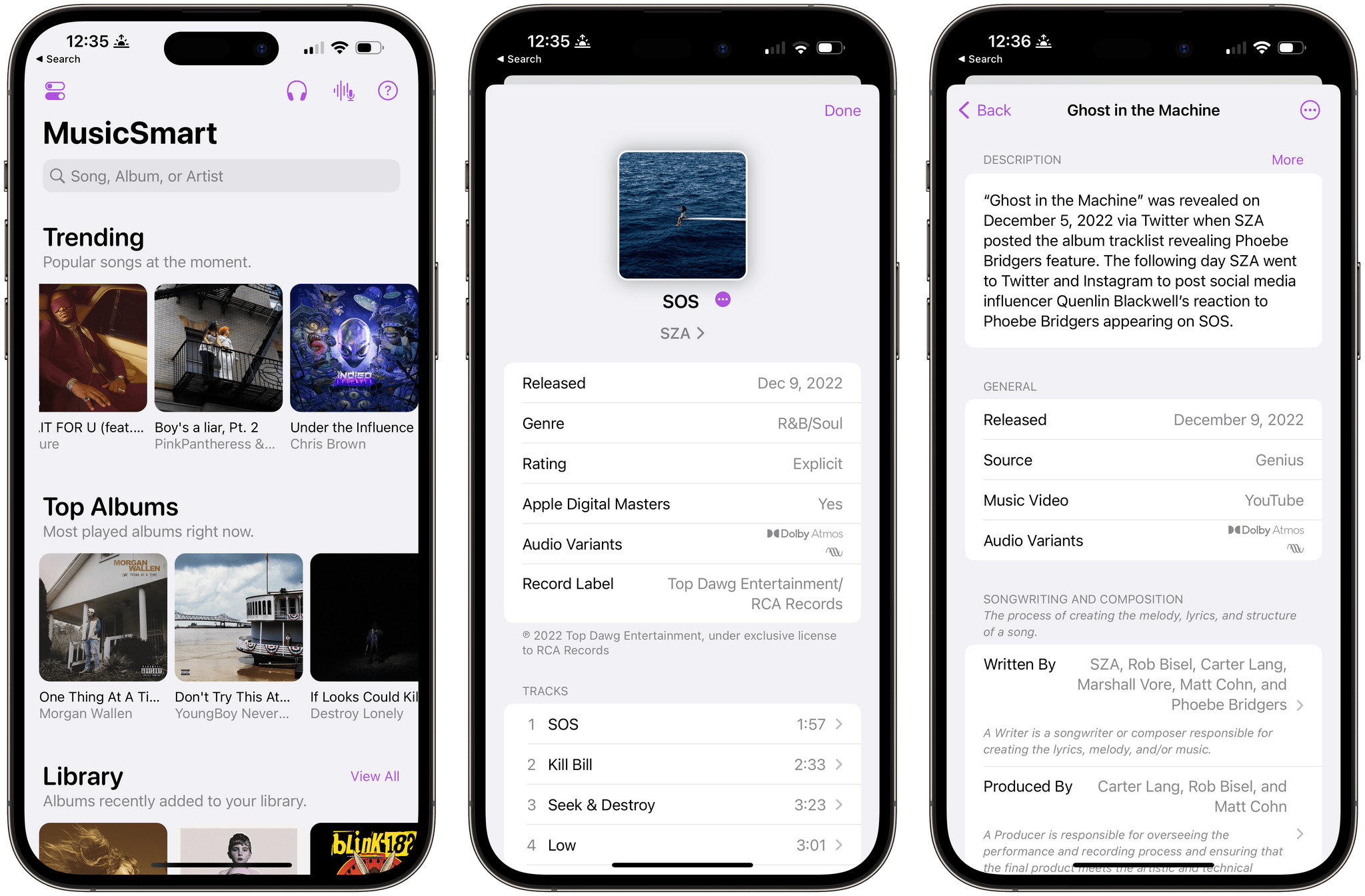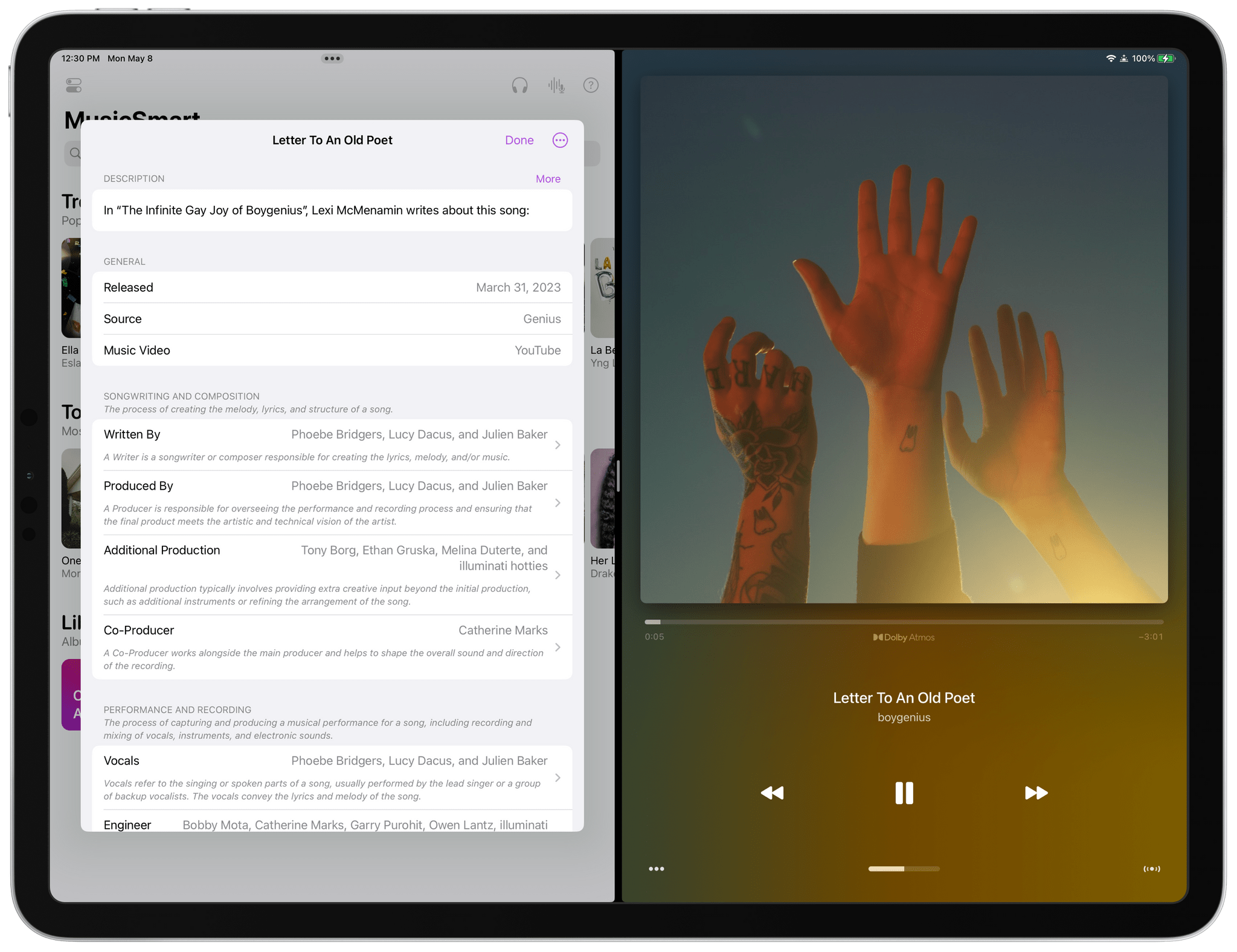It’s no secret that we’re big fans of Marcos Tanaka’s music apps at MacStories. MusicHarbor makes keeping up with new and upcoming releases a breeze, and MusicBox ensures you won’t lose track of music that you don’t have time to enjoy until later. The apps are indispensable for music fans who follow a long list of artists.
MusicSmart, which is available for the iPhone, iPad, Mac, and Apple TV, is a little different than Tanaka’s other apps. Instead of casting a broad net to track the entire range of your musical tastes, the app is about digging deeper into individual songs, albums, or artists’ catalogs. But follow the threads offered by MusicSmart, and the narrow focus that sets it apart from Tanaka’s other apps will paradoxically lead to new musical discoveries and, ultimately, broaden your tastes.
As Federico explained in his review of MusicSmart’s debut:
Whether by design or as a byproduct of our new habits, metadata and credits don’t play a big role in modern music streaming services. We’re frustrated when a service gets the title of a song wrong or reports the incorrect track sequence in an album, but we don’t consider the fact that there’s a world of context and additional information hidden behind the songs and albums we listen to every day. That context is entirely invisible to us because it’s not mass-market enough for a music streaming service. There have been small updates on this front lately, but by and large, credits and additional track information are still very much ignored by the streaming industry. And if you ask me, that’s a shame.
Despite stiff competition among music streaming services, the state of liner notes hasn’t improved since Federico wrote that. Fortunately, though, MusicSmart has only gotten better, adding new data sources, better organization, and more polish with each release. However, version 2.0 of the app combines its existing strengths with new features and an improved design in a way that transcends earlier versions, making this version 2.0 of MusicSmart feel more fully realized than ever before.
With the update, MusicSmart’s song credits have been organized into sections, pulling source material together into groupings like Songwriting and Composition, Performance and Recording, Instruments, and more. Within each of those new groupings is an explanation of each role or instrument, which is a great way to learn more about music production. For example, there are short explanations of what a Recording Engineer, a Mixing Engineer, and a Mastering Engineer do, which provides valuable context if you’re not familiar with those roles.
As with prior versions of MusicSmart, you can tap on any of the people involved with a song to see their other work. As I write this, I’ve been poking around in the liner notes for The National’s latest album, First Two Pages of Frankenstein, where I learned that Once Upon a Poolside was mixed by Jon Low, who also worked on two of Taylor Swift’s recent albums, which I didn’t know.
MusicSmart offers a lot of information about songs by default. However, with the latest version, you can turn off any of the app’s nine sections in the app’s settings. Also, longer sections like editorial content are truncated, offering a ‘More’ button to expand the section, making it easier to navigate liner notes with long editorial sections.
I’m also a big fan of the app’s new dynamic ‘Now Playing’ screen. If you tap the headphones icon from the app’s default screen, it will show the liner notes for the currently-playing song, which will update when the next song starts. The new feature is especially useful when added to a Split View or a stage in Stage Manager on the iPad, so it can be used side-by-side with your music app.
MusicSmart 2.0 also adds:
- Trending and Top Albums sections on the app’s main screen to help you discover new music
- A unified search field that returns results for songs, albums, and artists
- Liner notes from MusicBrainz
- Two new album review sources: ‘Rate Your Music’ and ‘Album of The Year’
- The ability to add music to Tanaka’s other app, MusicBox
- Integration with Overcast for podcast data
The Mac app has been updated with many of the features that the iPhone and iPad versions of MusicSmart have added, too, including new data sources and a refreshed design, but not the new dynamic ‘now playing’ or existing music recognition features. On the Mac, one feature I’d love to see in the future is a menu bar app that can be summoned by a global keyboard shortcut and uses ShazamKit to identify songs automatically.
I’ll be the first to admit that a lot of my music listening is a sort of background soundtrack to my day, whether I’m doing something like writing this review or cleaning up around the house. However, with my favorite albums – the ones I return to over and over – I love having MusicSmart by my side. The app allows me to learn more about the many people involved with my favorite albums beyond the performers themselves. Best of all, though, it’s browsing MusicSmart’s liner notes that leads to brand-new music discoveries.
MusicSmart is available on the App Store as a free update for existing users and for a one-time payment of $3.99 for new users.








